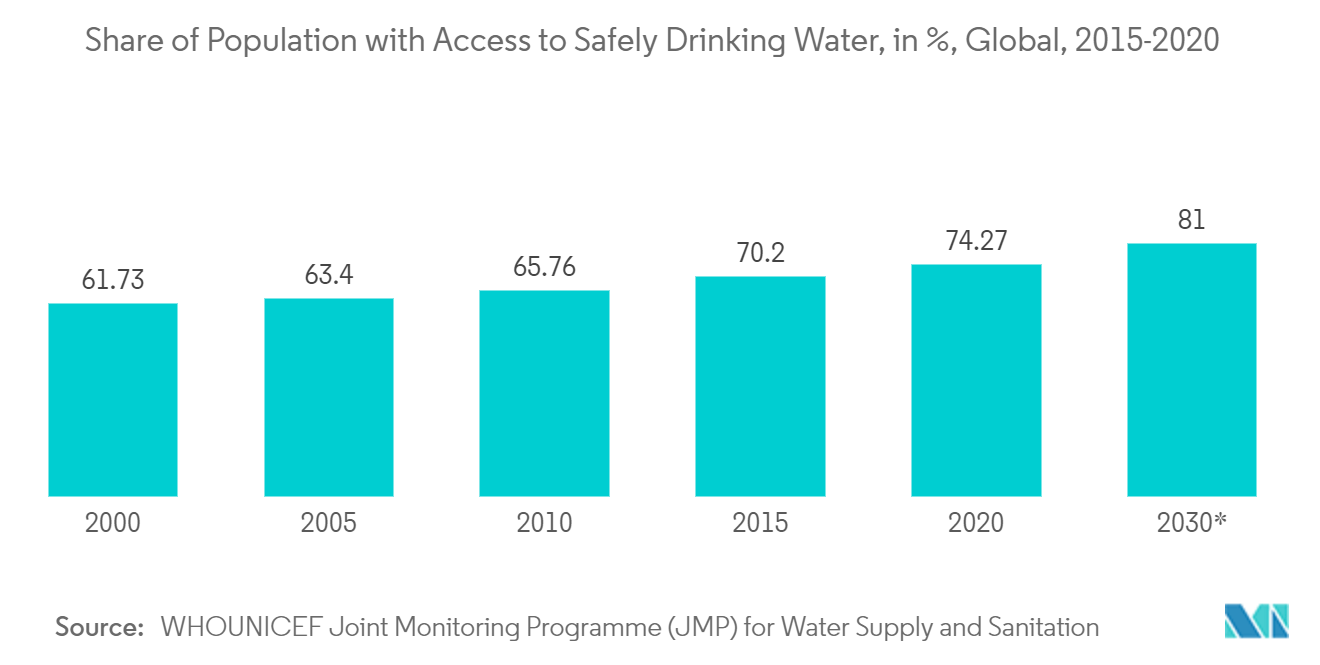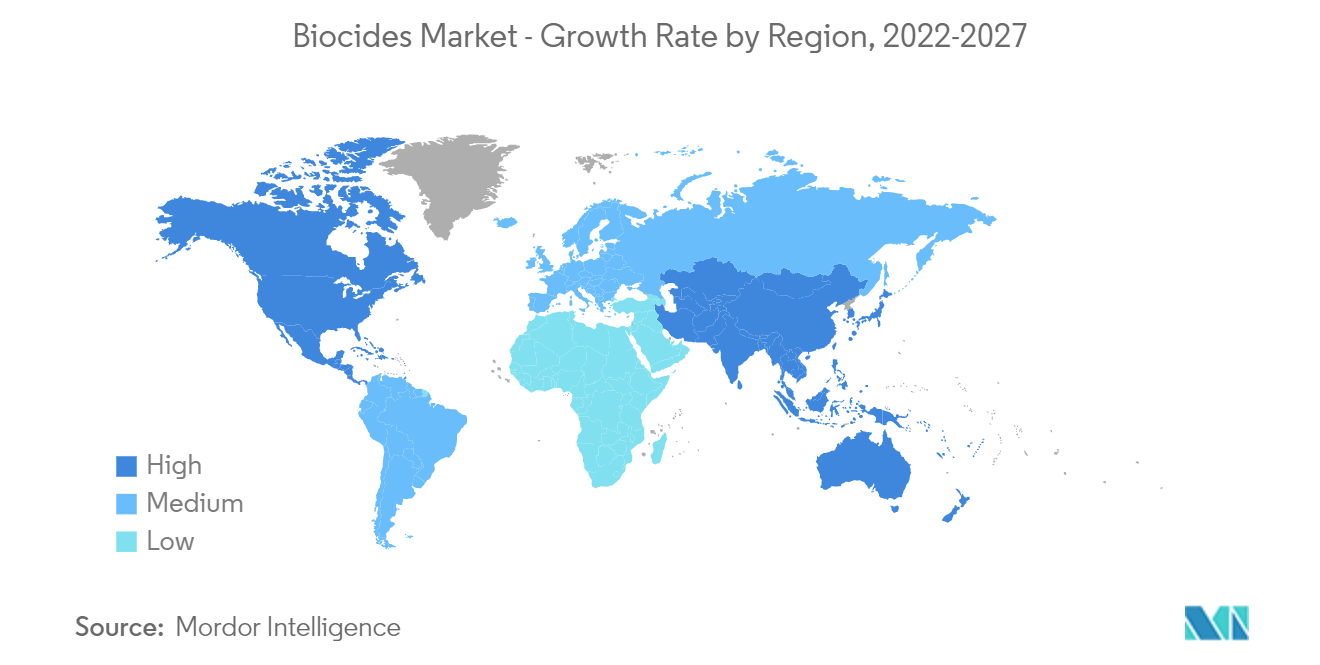Market Trends of Biocides Industry
This section covers the major market trends shaping the Biocides Market according to our research experts:
Increasing Usage in the Water Treatment Application
- Biocides are used in water treatment to eliminate microbes. Water towers are ideal locations for the growth of biological organisms, such as bacteria, algae, fungi, sulfate-reducing bacteria, and protozoa. If their growth is not controlled, they form a layer of bio-slime that acts as a natural adhesive surface for scale formation, which may reduce the cooling system's efficiency. For water systems to operate at their optimum efficiency, biocides are added to the water to remove the slime, microbiological fouling, and biofilm from these systems.
- These chemicals are widely used in cooling towers, spas and swimming pools, sewage treatment, and industrial wastewater treatment. Biocides are also used in water cleaning programs to control biofouling in reverse osmosis membranes. These biocides are used before the RO system to regulate bio-growth in the membrane.
- As per a UNICEF report, nearly 74% of the global population has access to safe drinking water, which is likely to reach 81% by 2030, leaving 1.6 billion without any safe drinking water.
- Due to the increase in the urban population throughout China, 70% of the nation's population is expected to reside in cities by 2030. As the urban population increases, it also faces an influx of wastewater and sludge. Currently, 80% of sludge in China is improperly dumped, an increasingly controversial environmental issue that has urban centers scrambling to decrease pollution by improving their wastewater treatment plants (WWTPs).
- India has been producing a significant quantity of industrial and urban wastes annually. The disposal of the sewage sludge has now become a serious problem due to rapid industrialization and urbanization during the last few decades. An estimated 38,354 million liters of sewage with an equivalent amount of sludge per day is presently generated in India. The nutrient potential of available wastewater in India is expected to be more than 350,000-ton N, 150,000-ton P, and 200,000-ton K per year.
- According to the United States Environmental Protection Agency, the country signed the Infrastructure Investment and Jobs Act, also known as the Bipartisan Infrastructure Law. This will allocate investments of more than USD 50 billion for improving America's drinking water, wastewater, and stormwater infrastructure.
- The UN estimates that 1.8 billion people will be living in countries or regions with absolute water scarcity by 2050, with Sub-Saharan Africa counting the largest number of water-stressed countries of any region. UN urged the countries to develop technologies related to water treatment and increase investment in this sector.
- The minister of energy in the United Arab Emirates announced investments in water treatment plants and new desalination plants in Abu Dhabi, Dubai, and Umm Al Qaiwain amounting to AED 7.63 billion (~USD 2.08 billion), in line with the directives of the UAE's leadership to achieve water security.
- With increasing demand from water treatment applications, the demand for biocides is also rapidly increasing.

North American Region to Dominate the Market
- The North American region is expected to dominate the market. In the region, the United States is the largest economy in terms of GDP. The United States is one of the largest markets for biocides, and it is expected to grow during the forecast period due to the growing end-user industries, such as water treatment, paints, coatings, food, and beverage, etc.
- Due to the aging of the existing water and wastewater treatment units in the country, the United States Environmental Protection Agency (USEPA) is emphasizing the improvement of water and sewage services, especially municipal wastewater treatment services. The organization also estimates a capital investment of USD 600 billion toward its improvement over the next two decades and is focused on using biological water treatment.
- Moreover, the United States Environmental Protection Agency (EPA) announced in January 2021 that 55 new projects in 20 states are invited to apply for approximately USD 5.1 billion in Water Infrastructure Finance and Innovation Act (WIFIA) loans. This funding will be leveraged to finance more than USD 12 billion in clean water and drinking water infrastructure projects in communities across the United States.
- According to the BAF Organisation, there are 14,748 wastewater treatment facilities in the United States. Demands for the treatment plants will grow more than 23% by 2032. Capital investment needs for the nation's wastewater and stormwater systems are estimated to total USD 271 billion over the next twenty years to meet current and future demands.
- According to Water Canada, the country is investing heavily in the construction of water treatment plants. The plant invested USD 7.37 billion in the Iona Island wastewater treatment plant. Canada invested USD 1.37 billion in the North End sewage treatment upgrades.
- Canada is investing USD 0.94 billion for the expansion of the Annacis Island wastewater treatment plant. Besides, USD 464.38 million has been allocated for the expansion of the Bonnybrook wastewater treatment plant.
- In Mexico, the water treatment industry is expected to register a healthy growth rate. The country has almost 2,477 municipal wastewater treatment plants, 2,639 wastewater treatment plants, 874 potable water treatment plants, and 435 desalination plants. Ongoing research in the country indicates that the government is mainly focused on the development of municipal wastewater treatment plants, mostly in the urban areas, which is likely to augment the market.

